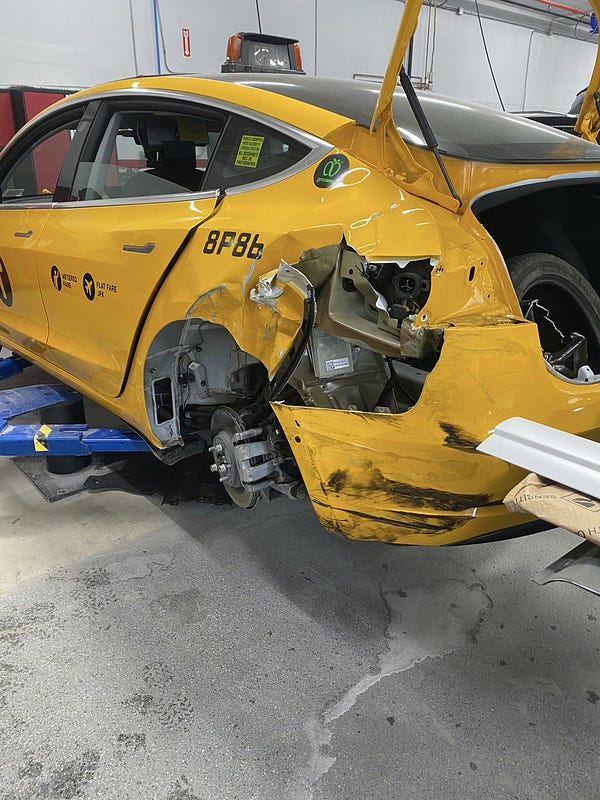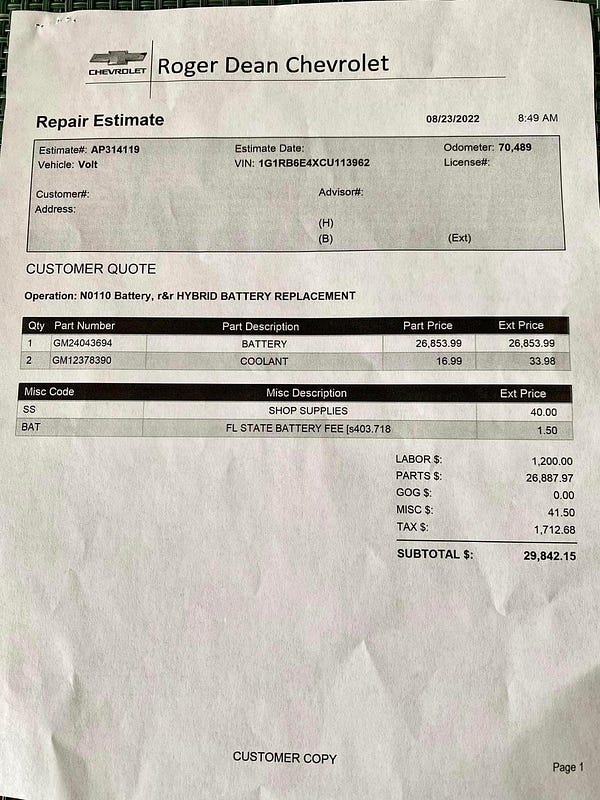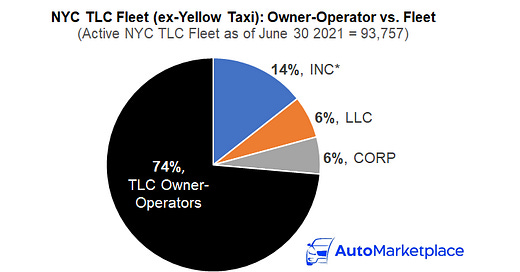

Discover more from AutoMarketplace
⚡ New TLC Plates To Be Split Between Drivers & EV Infrastructure, Mandate Might Be On Horizon
During NYC Council hearing, TLC Chair David Do outlined details and thinking around issuance of 1,000 new electric vehicle (EV) 'only' TLC plates. We share our thoughts on EVs in the NYC TLC market
⏱️Summary
🙋♂️ NYC Council Committee on Transportation and Infrastructure Hearing on October 13th: 3.5 hour hearing on NYC for-hire transportation (aka TLC) industry gave good insight into dynamics of market.
🔐 FHV License Pause: AutoMarketplace will cover the hearing over several pieces. This article focuses on the FHV License Pause (aka TLC Plate Cap) and the regulator’s EV strategy.
➕ 1,000 NEW TLC Plates: NYC Taxi & Limousine Commission (TLC) Chair David Do’s direct answer regarding why regulator decided to release 1,000 NEW electric vehicle (EV)-only licenses, relates to helping outer borough bases service Access-A-Ride and non-emergency medical transport (NEMT).
⚡ EV Transition Is Top TLC Priority & Mandate May Come Soon: Chair Do also indicated NEW plates were related to EV adoption goals. Full electrification plan, most likely leading to an eventual mandate, will be published soon.
➗ New TLC Plates Split 60 / 40: 1,000 new EV-only licenses will be split 60 / 40 between drivers and EV “infrastructure”.
❓ Addition of New Licenses Questioned : Questions arose related to strategy of releasing NEW TLC plates vs. converting existing fleet. Do implied unique incentive (i.e., ability of driver to get out of a TLC rental or ability of base to add vehicles), would push industry participants to adopt EVs.
🤔 Transition Costs & Dynamics Shouldn’t Be Underestimated: Most NYC drivers and fleets know how expensive and tricky transitioning to an EV currently is. TLC must be careful before pushing NYC drivers into long term financial commitments that may cause strain on driver income & personal finances.
There’s hardly ever a dull week in the NYC for-hire transportation (aka TLC) industry these days. From congestion pricing to driver pay raise proposals to the recent announcement that 1,000 EV-only FHV licenses (TLC plates) will be issued, the news is coming in fast.
An October 13th NYC Council Committee on Transportation and Infrastructure hearing provided some critical insight into the regulator’s, drivers’ and other industry participants’ thinking and concerns. We listened (& relistened) to the full 3.5 hours of testimony and decided to split up the key findings across several articles.
Today, we wanted to focus on the testimony related to the FHV License Pause (aka TLC Plate Cap) and the TLC’s related electrification strategy.
Of note, NYC TLC Chair David Do gave testimony that the recently announced 1,000 new ‘EV-only’ TLC Plates would be split 60% & 40% between drivers and EV “infrastructure”. More specific details will come in early December.
Why Issue New TLC Plates?
During the hearing, NYC Council Committee Chairperson Selvena N. Brooks-Powers asked TLC Chair & Commissioner David Do why the regulator decided to issue more for-hire vehicle (FHV) licenses (aka non-medallion TLC plates).
Chair Do made these two points in his direct response to this specific question:
"Traditional" black car & livery bases, primarily serving the outer boroughs have struggled to meet demand due to a lack of vehicles. For example, the underlying demand for certain services, such as Access-A-Ride and non-emergency medical transport (NEMT), are not being met, according to Do.
Pre-pandemic there were 120,000 active non-medallion TLC plates, while there are now only 95,000 active plates. An additional 1,000 plates, which will mostly be allocated to drivers, should not meaningfully add to congestion and impact the other goals of the FHV License Pause, including driver pay, according to Do.
✍️ AutoMarketplace Take
TLC Chair Do makes good overall points and is well spoken. However, we think the decision to release NEW FHV licenses is PRIMARILY about facilitating an EV transition vs. helping traditional black car and livery bases service Access-A-Ride and NEMT work.
With over 5,000+ inactive yellow medallion taxis, 4,000+ FHV licenses in storage and an existing wheelchair accessible vehicle (WAV) exemption to the FHV License Pause in place, THIS underlying reasoning and testimony does not make a lot of sense.
We appreciate Chair Do’s answer, but the logic in this specific testimony, when asked the question directly by the Committee Chairperson, doesn’t add up. Taxi medallion owners will further argue 120,000 vehicles was too much to begin with. Furthermore, as trip demand is still not near its pre-pandemic level and with an inflationary environment and weakening economy, ⚠️ adding more TLC vehicles at this point does not seem like a good idea ⚠️.
This answer will not be well received by many in the TLC industry, especially in the yellow taxi medallion sector. A primary way in which you help the taxi medallion market recover, requires crystal clear regulatory guidance that vehicle supply will be firmly controlled. Until for-hire trip demand and vehicle supply approaches imbalance, TLC vehicle supply must be tightly controlled. Why is this not obvious yet? 🤷♀️ With a City loan guarantee on medallion debt now, there is no more room for error on this matter.
A primary way in which you help the taxi medallion market recover, requires crystal clear regulatory guidance that vehicle supply will be firmly controlled. Until NYC for-hire trip demand and vehicle supply approaches imbalance, TLC vehicle supply must be tightly controlled. Why is this not obvious yet? A City loan guarantee exists on medallion debt now, there is no more room for error on this matter.
At different points in the hearing, as we write in the next section, we think Chair Do is more eloquent and makes clear the decision is much more related to electrifying the TLC fleet. However, even if a noble sustainability goal is the primary driver of the policy, THAT also can be pushed back against given all the inactive TLC vehicles noted above, from taxi medallions to other FHV licenses in storage.
NYC Public Advocate Jumaane Williams makes this exact point and politely pushes back in his prepared remarks. He urges the TLC to focus on the current for-hire fleet, if the underlying goal relates to sustainability. Mr. Williams also makes the point that adding an ADDITIONAL 1,000 for-hire vehicles can also add to congestion, circularly working against any sustainability goal.
EV Transition Should Be Priority, But Needs To Be Better Understood
We, AutoMarketplace, are a big believer in an electric vehicle (EV) future. In fact, our (we were previously known as TLCMKT) first YouTube video was reviewing a Chevy Bolt being used in the NYC TLC market. Our fleet division even tried to TLC plate a Tesla back in 2018, when it wasn’t that common. We spoke to several company fleet sales representatives and visited and spoke at length to employees at the sole NYC Tesla service center in Red Hook (Brooklyn).
We also realize that Tesla is no longer the only or primary mass market EV manufacturer. Almost all large OEMs and many new startups, such as Rivian and Lucid, are going to start offering more models in the coming years. It’s an exciting time and a new frontier that we all should look forward to⚡.
The TLC is right to focus on transitioning vehicles to electric (EV) from gas-powered (ICE). The TLC is right that more passengers are demanding sustainable transport options. However, one could also argue public transport 🚌 🚇 and other mobility options, such as bicycles 🚲, are satisfying a lot of the “front curve” 📈 sustainability-related trip demand, but let’s leave that aside for this piece.
Our team at AutoMarketplace “cut our teeth” in the NYC TLC fleet industry AND also through years of TLC driving. We know and have spoken to many TLC drivers and fleets over the years. We understand “on the street” problems well. There was a reason our fleet division (and many drivers we knew) didn’t buy Teslas (& other EVs) back in 2018 and why we (and they) don’t buy one now.
It has nothing to with us (or them) being ICE (gas) vehicle curmudgeons. Let’s explain.
EV Transition Costs & Dynamics Shouldn’t Be Underestimated
Again, to be clear, we’re not arguing against EV adoption, but rather highlighting some of the key issues that are preventing more widespread use of electric vehicles among the NYC TLC driver and fleet community. For reference, currently ~1%, or 863 vehicles, in the non-medallion TLC fleet are EVs. We know this number needs to go up. Many companies, drivers, and entrepreneurs (we hope to be among them) also want the number to go up and help solve the challenges we outline below.
Our commentary is merely a snapshot of today’s reality and specific to NYC’s for-hire transportation market (the same may not hold true for another city). Since Chair Do implied an EV mandate might soon be on the horizon, we think it’s more important than ever for the regulator and other political decision makers to deeply understand several, some not so obvious, dynamics involved in an EV transition.
Prohibitive Entry Costs For Most
While EVs are becoming cheaper and the pre-owned EV market is developing, EVs still provide drivers fewer options and generally have a higher entry price, even with tax credits, vs trusted TLC stalwarts like the Toyota Camry.
Yes, cheaper options are coming and averages can be skewed by expensive EVs. However, the market for less than $35,000 EVs is almost non-existent or in very scarce supply. Try looking for an EV priced less than $35,000 that is also not 4+ years old, it’s not easy.

Charging Time & Infrastructure
To encourage a driver to buy an EV, that likely needs to be financed in a rising rate environment, with the hope that it will help spur the development of EV infrastructure is respectfully, not a good strategy. It should actually be the other way around. 🤔 Currently, there are three main types of chargers: Level 1, Level 2, and Level 3, often known as a DC Fast Charger.
What most TLC drivers will be looking for are DC Fast Chargers. New York State provides a helpful and dynamic EV charger map (link to map) which we can reference. As you can see, there are currently less than 50 public DC Fast Charging stations in the NYC area! (Note: A charging station can have multiple individual chargers). More will come with time, but to service the 100,000+ TLC vehicle fleet on top of the ~2 million non-TLC vehicles registered to an NYC area address, the current charging infrastructure is EXTREMELY FAR from where it needs to be.
While one can make fun of the Fields of Dreams argument that “if you build it, they will come”, it’s quite clear to us that this is the correct strategy. You must build the infrastructure FIRST, before having drivers make a $45,000+ vehicle investment. Not the other way around. If you don’t, drivers can be the victim of EV charging “waiting lines”, which can cut into driver earnings significantly. If a driver saves on gas, to then lose hours waiting for their vehicle to be charged, is that saving them money?
You must build the infrastructure FIRST, before having drivers make a $45,000+ vehicle purchase. Not the other way around.
Range Concerns
When many think about the range of an electric vehicle, they often don’t convert it into a MPG equivalent (i.e., very few people will say a full tank of gas has 400 miles of range). For example, if a Tesla Model 3 has 300 miles of range on a full charge, many assume that means the car will drive around 300 actual miles before it needs to be recharged. However, that range is an estimate based on traffic-less driving in ideal weather conditions. In reality, 300 miles of range may convert into 90 NYC “TLC miles”, given traffic dynamics and weather conditions (i.e., heater or A/C is turned on).
Rami, a TLC driver who was driving one of the first Tesla yellow cabs in NYC, mentions this in the below video (Rami speaks about the true EV range starting at 3:32).
Lack of 3rd Party Service & Parts Infrastructure
The lack of an independent service and parts ecosystem for EVs is something many don’t think about. What do we mean by this?
Taking a page out of Apple’s playbook, many vehicle manufacturers don’t allow third parties to service their EVs. This is highly unusual for the auto industry and will be discomforting for many drivers and fleets.
Drivers and fleets, in general, do not like relying on dealerships, which often charge high labor rates (i.e. $180+ per hour) and are sales-centric organizations.
Fleets can own their own repair facilities or negotiate discounts, passing on cost savings to drivers who wouldn’t be able to work out such deals as individual operators.
Dealerships usually have slow turnaround times, which can cost drivers and fleets thousands of dollars in lost income.
Drivers and fleets often source parts from independent stores and vendors at cheaper prices than dealers sell them for.
Drivers often engage independent auto repair shops that charge lower labor rates and are locally owned.
For example, Tesla has one main service center in NYC located in Brooklyn. While the overall rating for the center is good, if you sort by what’s dragging the rating lower, it appears service issues are causing a lot of problems for customers.
Our primary point is not that Tesla/Other EV dealerships are horrible, but rather there are no service and repair alternatives. Today, if a TLC driver doesn’t like a specific Toyota dealer there are many other technicians, mechanics or service providers they can go to, including pursuing DIY strategies.
In addition, if a vehicle needs body work, as often happens in the TLC industry, it’s not clear that a large enough body shop network exists for EVs.


Question Around Battery Warranty
It’s also important to consider whether a vehicle manufacturer voids warranties, specifically the critical battery warranty, if a vehicle is used commercially (i.e. rideshare). Replacing or repairing a degraded or malfunctioning battery can be prohibitively expensive.
Technological Obsolescence
Technological obsolescence is when hardware (or software) is no longer needed or wanted even though it could still be in working order. There are multiple real-life examples that all of us have witnessed in our lifetimes (i.e. VHS < DVD < streaming OR original iPhone < iPhone 5 < iPhone 12). There is no reason, why this sort of technology progression won’t happen in the EV industry.
Today, an EV may get 350 miles of range and take 20 minutes to charge (DC), but in 5 years time an EV may be able to get 600 miles of range and charge in 5 minutes (solid state battery). While, over-the-air updates can help improve older tech, it is likely reasonable to assume there are certain hardware upgrades that would effectively make older models technologically obsolete with time.
The reason this is a very different and an important consideration as it relates to EVs, is the initial cost of the technology product that becomes obsolete. Most people really didn’t feel the impact of their DVD player or Blackberry becoming obsolete because the financial impact was relatively minimal. A $55,000 vehicle becoming obsolete in 5 years will have a significant financial impact for most, including drivers and fleets.
The reason this is a very different and an important consideration as it relates to EVs, is the initial cost of the technology product that becomes obsolete. Most people really didn’t feel the impact of their DVD player or iPhone becoming obsolete because the financial impact was relatively minimal. A $55,000 vehicle becoming obsolete in 5 years will have a significant financial impact for most, including drivers and fleets.
EV Is The Future, But It’s Not So Simple
While the above analysis sounds like we are anti-EV, we are not. We believe EVs should and will come to dominate the NYC TLC industry over time. However, there are certain practical financial and operational considerations that City drivers and fleets have to uniquely weigh before deciding to make the switch to EVs. Today, we think it’s too early for most TLC drivers and fleets to adopt EVs, but that opinion could change as new vehicles, technology and infrastructure become available. Regulators and policymakers must understand this before forcing adoption.
To conclude, look no further to EV pioneer & Tesla CEO Elon Musk’s own guidance as to how long an EV transition might take. While, it might not be politically popular to take this stance, our interest is to be objective and report “on the ground” realities. It’s important for all stakeholders to work together and have tough, but fruitful discussions before any definitive TLC industry EV roadmap is laid out.
“It will take another 20 years for cars to be fully electric. It is like with phones, you cannot replace them all at once” - Elon Musk
As always, let us know your thoughts in the comments section below or by emailing us at info@automarketplace.com.
AutoMarketplace.com NYC covers the for-hire transportation industry and automotive news. Check out AutoMarketplace.com on YouTube ▶️
















Excellent, comprehensive article on EVs. There is nothing I could add to this other than to say a 240 mile-range Tesla that is realistically only about 80 miles doesn’t work for me at all. 80 miles is well within 1/3 to half of the miles I typically do in a shift. This is wholly unacceptable for me as an FHV driver and the fear of running out of power is real and not to mention the number of trips I would have to turn down once the range decreases to near zero miles.
I wish more analysis would have been made on the FHV profitability taking into consideration higher monthly car payments (due to vehicle being roughly 2-3 times of a typical gasoline engine vehicle) and disruption to income due to charging issues, which for me would be 2-3 times per shift in the winter, for example.
Thanks again for excellent analysis and reporting.